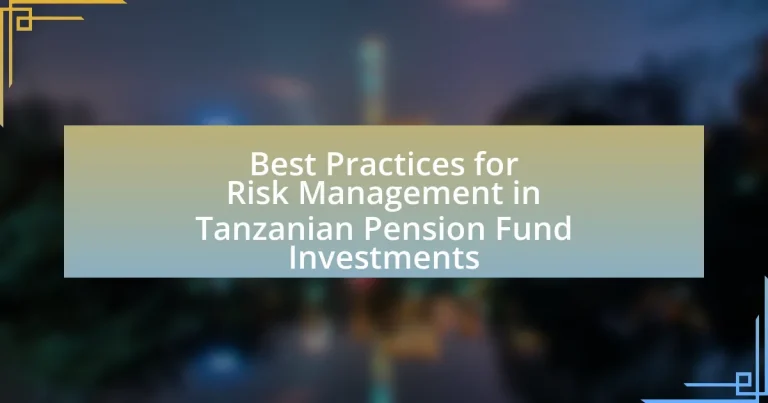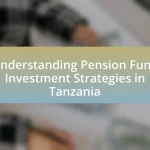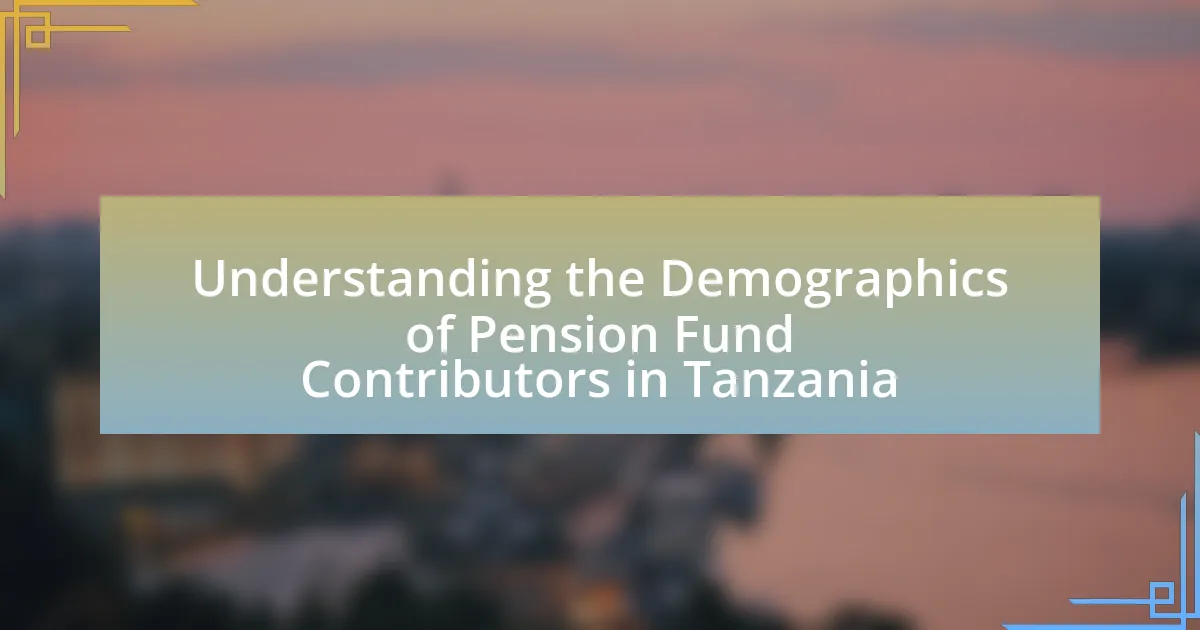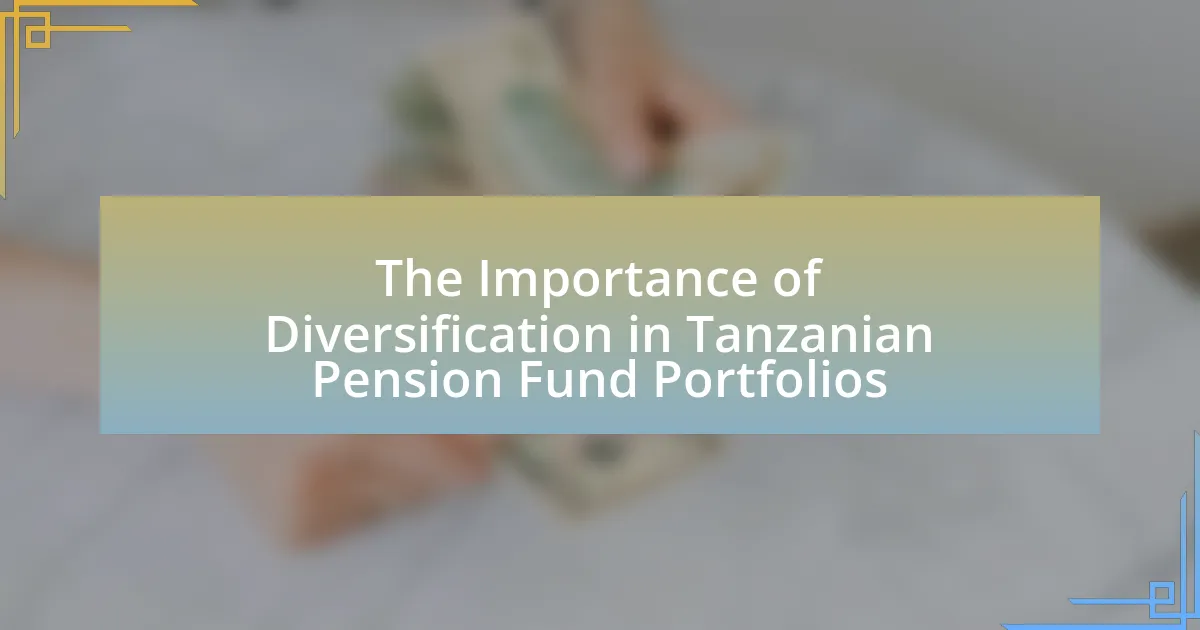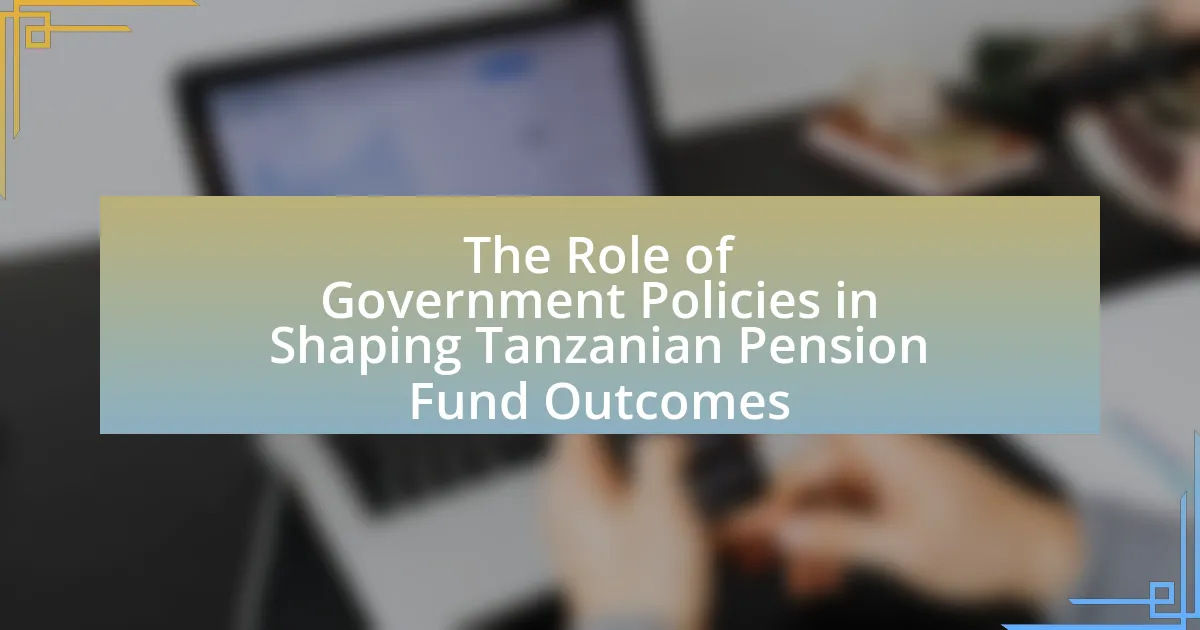The article focuses on best practices for risk management in Tanzanian pension fund investments, emphasizing the importance of diversification, regular risk assessments, compliance with regulatory frameworks, and active monitoring of investment performance. It outlines specific strategies such as risk avoidance, reduction, sharing, and retention, which align with the Pension Funds Act of 2008 to enhance financial stability and sustainability. The article also discusses the types of risks faced by pension funds, the role of stakeholders in risk management, and the challenges in implementing effective practices, while highlighting the influence of international standards and technological tools on local risk management strategies.
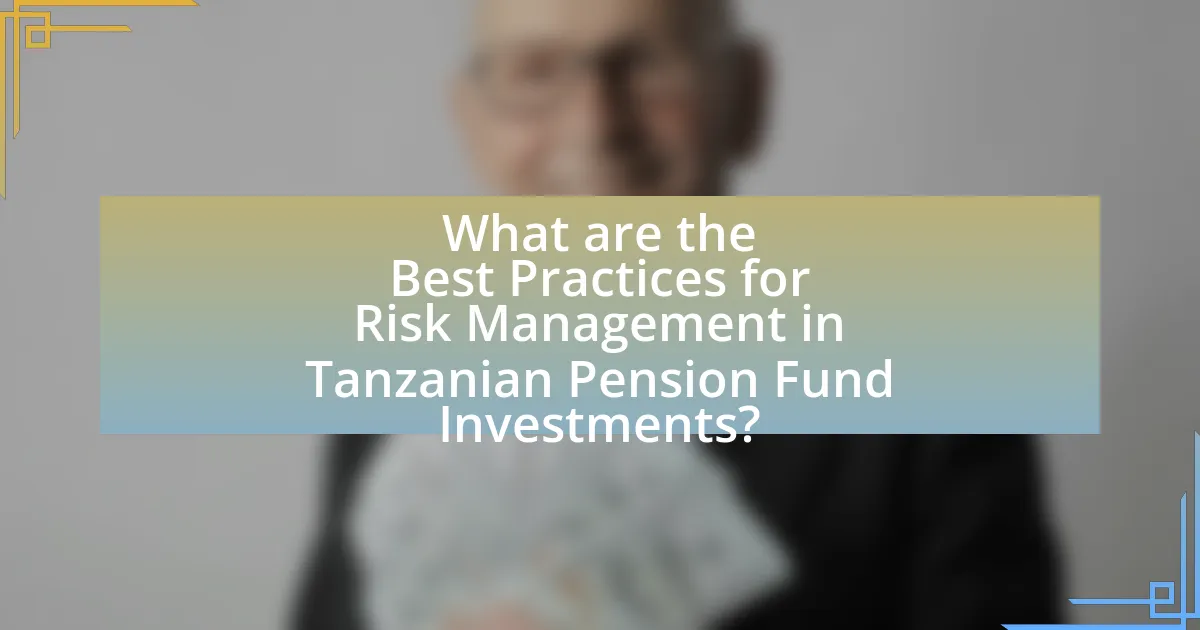
What are the Best Practices for Risk Management in Tanzanian Pension Fund Investments?
The best practices for risk management in Tanzanian pension fund investments include diversification, regular risk assessment, adherence to regulatory frameworks, and active monitoring of investment performance. Diversification across asset classes, sectors, and geographical regions helps mitigate risks associated with market volatility. Regular risk assessments enable pension funds to identify potential threats and adjust their strategies accordingly. Compliance with the regulatory frameworks established by the Pension Funds Act of 2008 ensures that funds operate within legal parameters, reducing the risk of penalties or mismanagement. Active monitoring of investment performance allows for timely adjustments to portfolios, ensuring alignment with the fund’s risk tolerance and investment objectives. These practices collectively enhance the resilience and sustainability of pension fund investments in Tanzania.
How do these best practices enhance investment performance?
Best practices for risk management enhance investment performance by systematically identifying, assessing, and mitigating potential risks, which leads to more stable returns. For instance, implementing diversification strategies reduces exposure to any single asset’s volatility, thereby protecting the overall portfolio. Research indicates that diversified portfolios can reduce risk without sacrificing returns, as evidenced by a study from the CFA Institute, which found that diversified investments can outperform concentrated ones over time. Additionally, regular monitoring and rebalancing of the investment portfolio ensure alignment with risk tolerance and investment goals, further optimizing performance.
What specific strategies are employed in risk management?
Specific strategies employed in risk management include risk avoidance, risk reduction, risk sharing, and risk retention. Risk avoidance involves eliminating activities that expose the organization to risk, such as not investing in volatile markets. Risk reduction focuses on minimizing the impact of risks through measures like diversification of investments, which is crucial for pension funds to mitigate potential losses. Risk sharing distributes the risk among multiple parties, often through insurance or partnerships, thereby reducing the burden on a single entity. Lastly, risk retention accepts certain risks as part of the business strategy, often when the cost of mitigation exceeds the potential loss. These strategies are essential for effective risk management in Tanzanian pension fund investments, ensuring stability and sustainability in the face of market fluctuations.
How do these strategies align with regulatory requirements?
The strategies for risk management in Tanzanian pension fund investments align with regulatory requirements by ensuring compliance with the Pension Act of 2008 and subsequent regulations. These strategies incorporate risk assessment frameworks that adhere to the guidelines set forth by the National Social Security Fund (NSSF) and the Pension Regulatory Authority, which mandate prudent investment practices to protect beneficiaries’ interests. For instance, diversification of investment portfolios is a regulatory requirement aimed at minimizing risk exposure, thereby aligning with the legal framework that governs pension fund operations in Tanzania.
Why is risk management crucial for pension fund investments?
Risk management is crucial for pension fund investments because it safeguards the financial stability and long-term viability of the fund. Effective risk management identifies, assesses, and mitigates potential financial losses that could arise from market volatility, interest rate fluctuations, and demographic changes. For instance, according to the International Monetary Fund, pension funds that implement robust risk management strategies can reduce their exposure to adverse market conditions by up to 30%. This proactive approach ensures that pension funds can meet their obligations to beneficiaries while maintaining sustainable growth.
What types of risks do pension funds face in Tanzania?
Pension funds in Tanzania face several types of risks, including investment risk, regulatory risk, liquidity risk, and demographic risk. Investment risk arises from fluctuations in asset values, which can affect the fund’s ability to meet its obligations. Regulatory risk is linked to changes in laws and regulations that can impact fund operations and compliance requirements. Liquidity risk refers to the potential inability to meet short-term financial obligations due to insufficient liquid assets. Demographic risk involves uncertainties related to changes in the population, such as life expectancy and retirement age, which can affect the fund’s long-term sustainability. These risks necessitate robust risk management practices to ensure the financial health of pension funds in Tanzania.
How can effective risk management mitigate these risks?
Effective risk management can mitigate risks in Tanzanian pension fund investments by identifying, assessing, and prioritizing potential threats to the fund’s assets. By implementing a structured framework, such as the Enterprise Risk Management (ERM) approach, pension funds can systematically evaluate market volatility, regulatory changes, and investment performance. For instance, a study by the International Monetary Fund highlights that pension funds employing robust risk management strategies can reduce investment losses by up to 30% during economic downturns. This proactive approach enables funds to allocate resources efficiently, diversify portfolios, and establish contingency plans, ultimately safeguarding the financial security of beneficiaries.
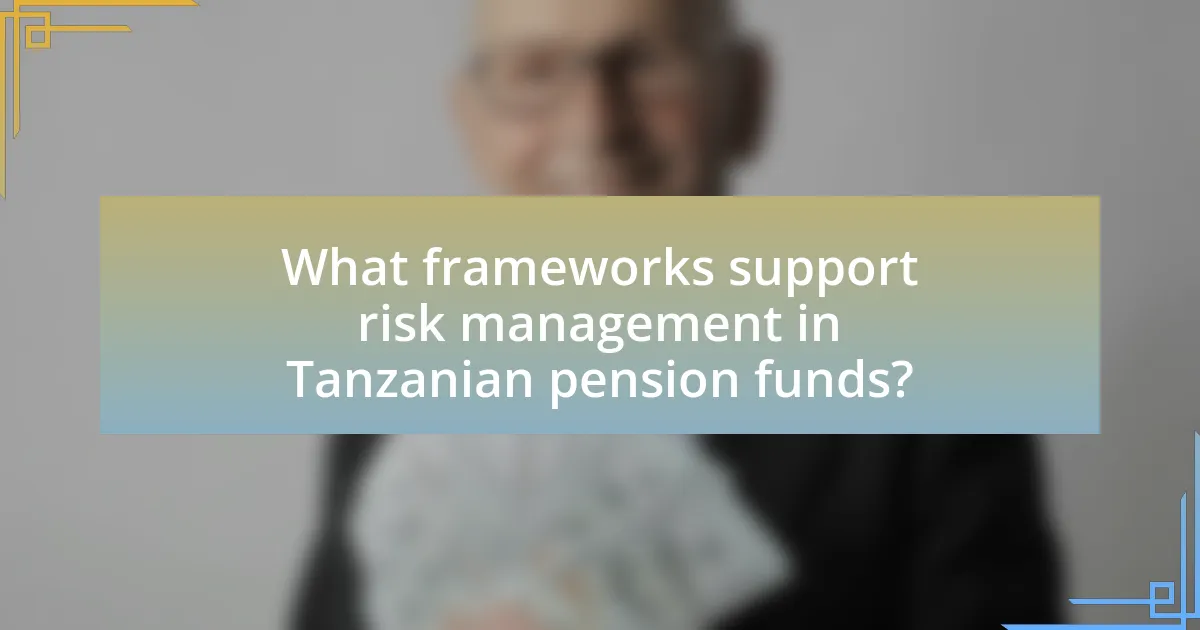
What frameworks support risk management in Tanzanian pension funds?
The frameworks that support risk management in Tanzanian pension funds include the National Pension Fund Act, the Social Security Regulatory Authority (SSRA) guidelines, and the International Financial Reporting Standards (IFRS). The National Pension Fund Act establishes the legal framework for pension fund operations, ensuring compliance and risk mitigation. The SSRA guidelines provide specific regulatory requirements for risk management practices, including investment strategies and asset allocation. Additionally, the adoption of IFRS enhances transparency and accountability in financial reporting, which is crucial for effective risk management. These frameworks collectively ensure that pension funds in Tanzania operate within a structured environment that promotes sound risk management practices.
How do international standards influence local practices?
International standards influence local practices by providing a framework for governance, compliance, and operational efficiency. In the context of Tanzanian pension fund investments, adherence to international standards such as the International Financial Reporting Standards (IFRS) and the Principles for Responsible Investment (PRI) helps local funds align their practices with global best practices. This alignment enhances transparency, risk management, and accountability, which are crucial for attracting both local and foreign investments. For instance, the adoption of IFRS has been shown to improve financial reporting quality, thereby increasing investor confidence and facilitating better decision-making in pension fund management.
What are the key international frameworks adopted in Tanzania?
Tanzania has adopted several key international frameworks, including the International Labour Organization (ILO) conventions, the United Nations Sustainable Development Goals (SDGs), and the African Union’s Agenda 2063. The ILO conventions focus on labor rights and social protection, which are crucial for pension fund management. The SDGs provide a global blueprint for sustainable development, influencing investment strategies in the pension sector. Agenda 2063 emphasizes economic growth and social inclusion, guiding Tanzania’s policies on pension fund investments. These frameworks collectively enhance the regulatory environment and promote best practices in risk management for pension funds in Tanzania.
How do these frameworks improve transparency and accountability?
These frameworks improve transparency and accountability by establishing clear guidelines and standards for reporting and governance in pension fund management. By mandating regular disclosures of financial performance, investment strategies, and risk assessments, these frameworks ensure that stakeholders, including beneficiaries and regulators, have access to relevant information. For instance, the implementation of the International Financial Reporting Standards (IFRS) in pension funds has been shown to enhance the quality of financial reporting, thereby increasing stakeholder trust and enabling better oversight. Additionally, frameworks that promote stakeholder engagement and feedback mechanisms further enhance accountability by allowing beneficiaries to voice concerns and influence decision-making processes.
What role do stakeholders play in risk management?
Stakeholders play a crucial role in risk management by providing diverse perspectives, resources, and expertise essential for identifying, assessing, and mitigating risks. Their involvement ensures that various interests are represented, which enhances the decision-making process. For instance, in the context of Tanzanian pension fund investments, stakeholders such as fund managers, regulators, and beneficiaries contribute to the development of risk management frameworks that align with both regulatory requirements and the financial goals of the fund. This collaborative approach leads to more robust risk assessments and the implementation of effective risk mitigation strategies, ultimately safeguarding the investments and interests of all parties involved.
Who are the key stakeholders in Tanzanian pension fund investments?
The key stakeholders in Tanzanian pension fund investments include the government, pension fund managers, contributors (employees), beneficiaries (retirees), and regulatory bodies. The government plays a crucial role in establishing the legal framework and policies that govern pension funds. Pension fund managers are responsible for the investment strategies and management of the funds. Contributors, who are typically employees, provide the capital through their contributions, while beneficiaries rely on these funds for their retirement income. Regulatory bodies, such as the Pension Funds Regulatory Authority, oversee compliance and ensure the protection of contributors’ interests.
How can collaboration among stakeholders enhance risk management?
Collaboration among stakeholders enhances risk management by facilitating the sharing of diverse perspectives and expertise, which leads to more comprehensive risk assessments. When stakeholders, such as fund managers, regulators, and beneficiaries, work together, they can identify potential risks more effectively and develop strategies that address these risks collaboratively. For instance, a study by the World Bank highlights that collaborative frameworks in financial sectors improve risk identification and mitigation, resulting in more resilient investment strategies. This collective approach not only strengthens the decision-making process but also fosters transparency and accountability, which are crucial for effective risk management in pension fund investments.
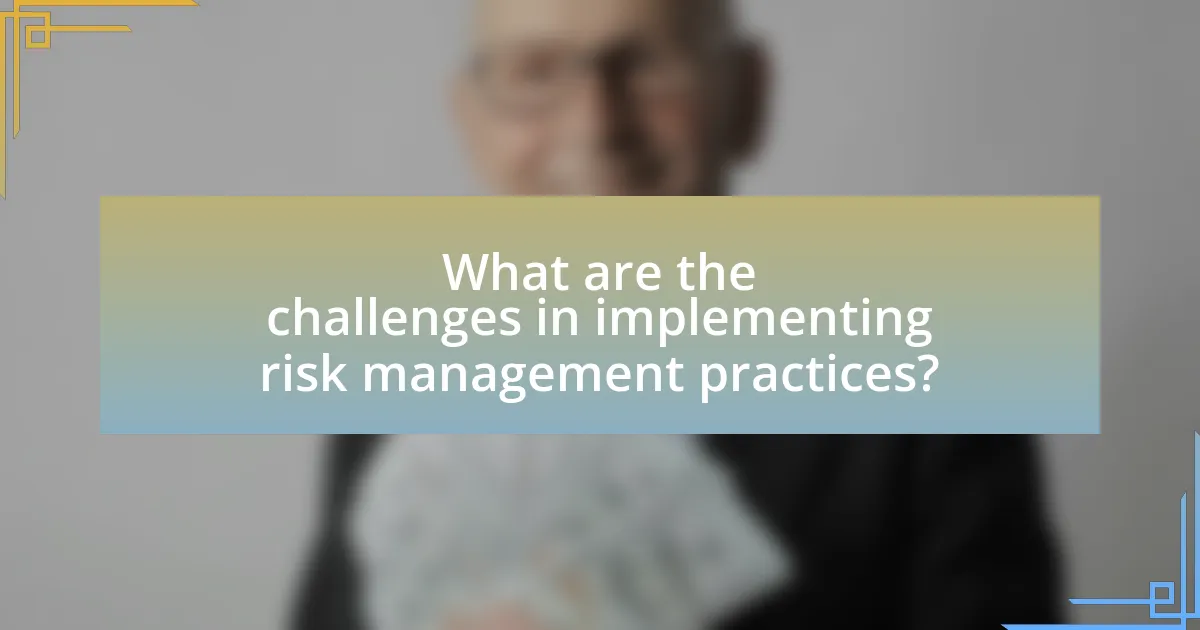
What are the challenges in implementing risk management practices?
The challenges in implementing risk management practices include a lack of awareness and understanding of risk management principles among stakeholders. This knowledge gap can lead to ineffective risk assessment and mitigation strategies. Additionally, limited resources, both financial and human, hinder the establishment of comprehensive risk management frameworks. According to a study by the World Bank, many pension funds in developing countries, including Tanzania, face difficulties in adopting best practices due to inadequate training and expertise in risk management. Furthermore, regulatory constraints and the dynamic nature of financial markets complicate the implementation process, making it essential for pension funds to adapt continuously to emerging risks.
What common obstacles do pension funds encounter?
Pension funds commonly encounter obstacles such as regulatory challenges, market volatility, and demographic shifts. Regulatory challenges arise from complex compliance requirements that can hinder investment strategies and increase operational costs. Market volatility affects asset valuations and can lead to significant fluctuations in fund performance, making it difficult for pension funds to meet their long-term obligations. Additionally, demographic shifts, including aging populations, create pressure on pension funds to ensure sufficient liquidity and sustainable payouts, as a growing number of retirees draw from the funds while fewer contributors are available. These factors collectively complicate the management and sustainability of pension funds.
How can these obstacles be addressed effectively?
Obstacles in Tanzanian pension fund investments can be effectively addressed through the implementation of robust risk assessment frameworks and diversification strategies. Establishing a comprehensive risk assessment framework allows pension funds to identify, analyze, and mitigate potential risks associated with market volatility and regulatory changes. For instance, the use of quantitative models can help in forecasting potential losses and in making informed investment decisions. Additionally, diversification across asset classes, sectors, and geographical regions reduces exposure to any single economic downturn, thereby enhancing overall portfolio stability. Research indicates that diversified portfolios can achieve better risk-adjusted returns, as evidenced by studies showing that funds with a broader asset allocation tend to perform more consistently over time.
What lessons can be learned from other countries’ experiences?
Countries like Sweden and the Netherlands demonstrate effective risk management in pension fund investments through diversified portfolios and robust regulatory frameworks. Sweden’s AP Funds utilize a mix of equities, fixed income, and alternative investments, achieving a 6.5% average annual return over the past decade, which highlights the importance of diversification in mitigating risks. The Netherlands employs strict governance structures and transparency, resulting in a funding ratio of over 100% for many pension funds, showcasing how regulatory oversight can enhance financial stability. These examples illustrate that adopting diversified investment strategies and strong regulatory practices can significantly improve risk management in pension funds.
How can technology improve risk management in pension funds?
Technology can improve risk management in pension funds by enhancing data analytics, enabling real-time monitoring, and facilitating better decision-making. Advanced data analytics tools allow pension funds to assess market trends, predict potential risks, and optimize asset allocation strategies. Real-time monitoring systems provide immediate insights into portfolio performance and risk exposure, allowing fund managers to respond swiftly to market fluctuations. Additionally, technology-driven platforms can streamline compliance processes and improve transparency, which is crucial for maintaining stakeholder trust. For instance, the integration of artificial intelligence in risk assessment has been shown to increase accuracy in predicting financial downturns, thereby reducing potential losses.
What technological tools are available for risk assessment?
Technological tools available for risk assessment include risk management software, data analytics platforms, and predictive modeling tools. Risk management software, such as RiskWatch and LogicManager, enables organizations to identify, assess, and mitigate risks effectively. Data analytics platforms like Tableau and Microsoft Power BI allow for the visualization and analysis of risk data, facilitating informed decision-making. Predictive modeling tools, such as SAS and IBM SPSS, utilize historical data to forecast potential risks and their impacts. These tools enhance the accuracy and efficiency of risk assessments, supporting better risk management practices in contexts like Tanzanian pension fund investments.
How do these tools enhance decision-making processes?
These tools enhance decision-making processes by providing data-driven insights that improve the accuracy and efficiency of evaluations. For instance, risk assessment tools analyze historical data and market trends, enabling pension fund managers in Tanzania to identify potential investment risks and opportunities. According to a study by the International Monetary Fund, effective risk management tools can lead to a 20% increase in investment returns by optimizing asset allocation strategies. This evidence demonstrates that utilizing these tools not only streamlines decision-making but also significantly contributes to better financial outcomes for pension funds.
What are the best practices for ongoing risk assessment?
The best practices for ongoing risk assessment include regularly updating risk profiles, employing quantitative and qualitative analysis, and integrating stakeholder feedback. Regular updates to risk profiles ensure that changes in market conditions, regulatory environments, and organizational objectives are reflected in the assessment process. Quantitative analysis, such as stress testing and scenario analysis, provides measurable insights into potential risks, while qualitative analysis captures subjective factors that may influence risk. Additionally, integrating feedback from stakeholders, including fund managers and beneficiaries, enhances the comprehensiveness of the assessment. These practices are essential for maintaining effective risk management in pension fund investments, as they allow for timely identification and mitigation of emerging risks.
How often should risk assessments be conducted?
Risk assessments should be conducted at least annually. This frequency aligns with best practices in risk management, ensuring that pension funds remain compliant with regulatory requirements and can effectively respond to changing market conditions. Regular assessments help identify new risks and evaluate the effectiveness of existing controls, thereby safeguarding the investments of pension fund members.
What metrics should be used to evaluate risk management effectiveness?
Key metrics to evaluate risk management effectiveness include Value at Risk (VaR), which quantifies potential losses in investment portfolios under normal market conditions, and the Sharpe Ratio, which measures risk-adjusted return by comparing excess return to its standard deviation. Additionally, the Sortino Ratio, which focuses on downside risk, and the Maximum Drawdown, which assesses the largest peak-to-trough decline, are critical for understanding risk exposure. These metrics provide a quantitative basis for assessing how well risk management strategies are performing, enabling pension funds to make informed investment decisions.
What practical tips can enhance risk management in Tanzanian pension funds?
To enhance risk management in Tanzanian pension funds, implementing a diversified investment strategy is essential. Diversification reduces exposure to any single asset or risk factor, thereby stabilizing returns. For instance, allocating funds across various asset classes such as equities, bonds, and real estate can mitigate risks associated with market volatility. Additionally, conducting regular risk assessments and stress testing can identify potential vulnerabilities in the investment portfolio, allowing for timely adjustments. According to the National Social Security Fund of Tanzania, effective risk management practices can lead to improved financial sustainability and better member benefits.
